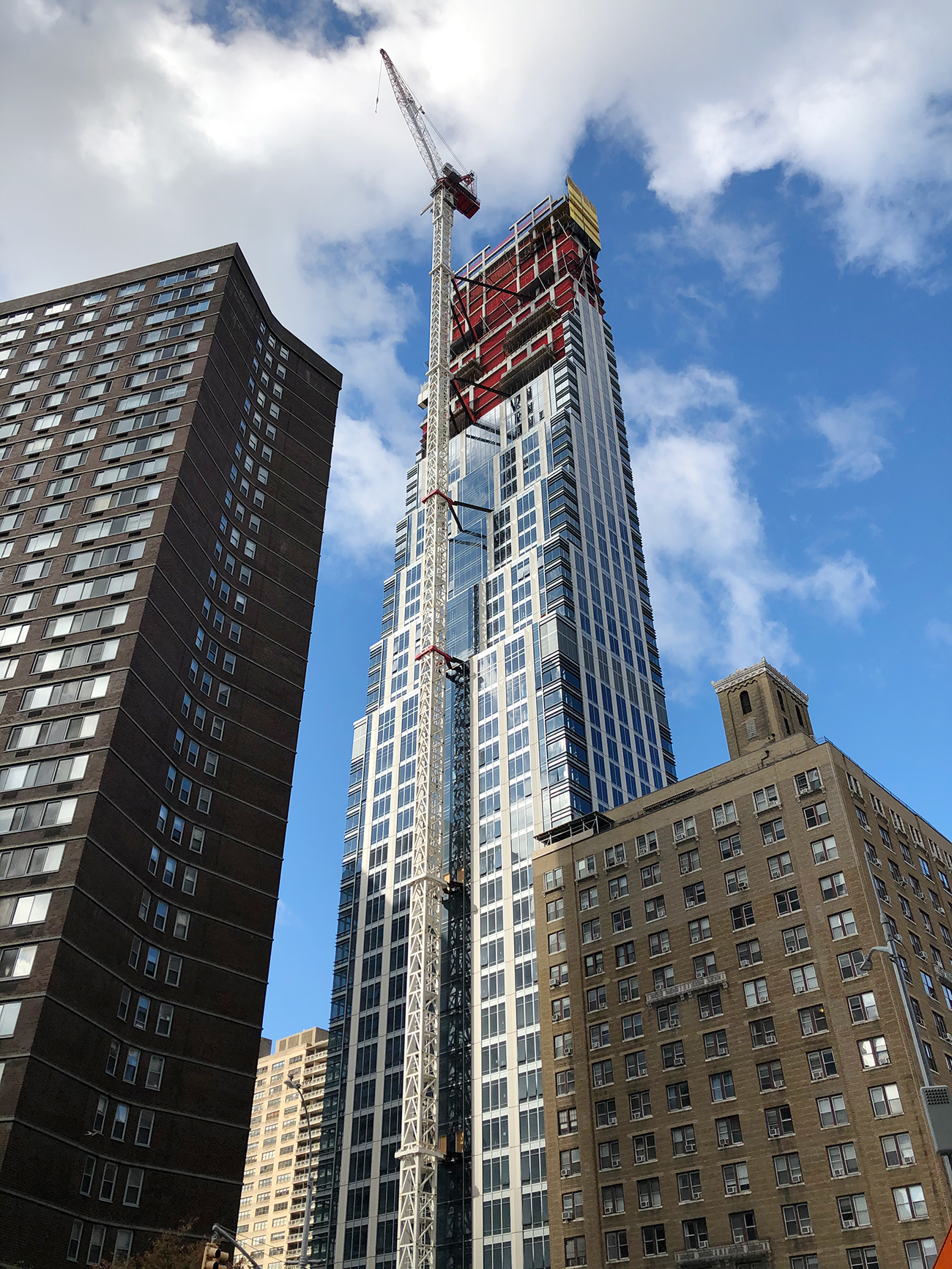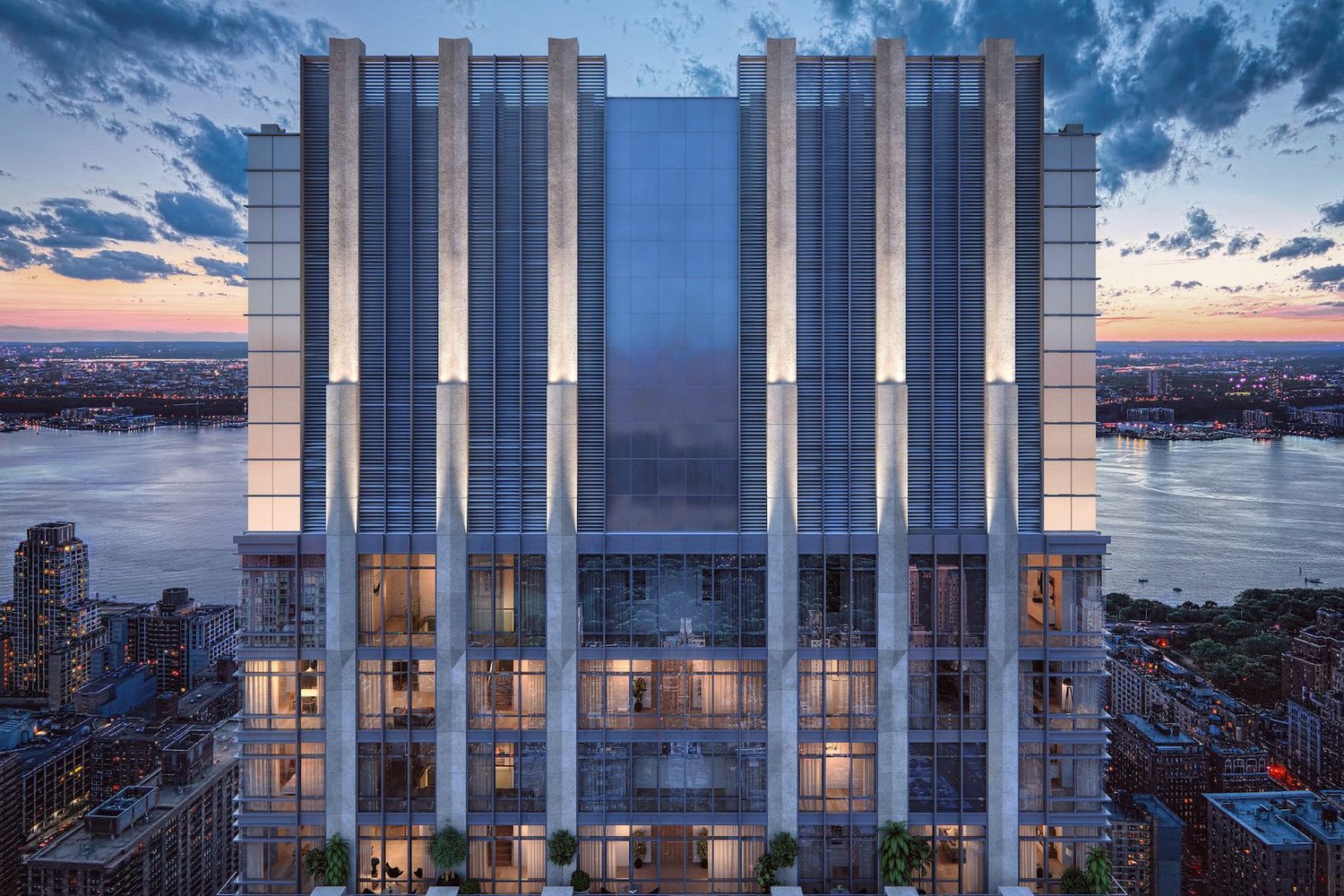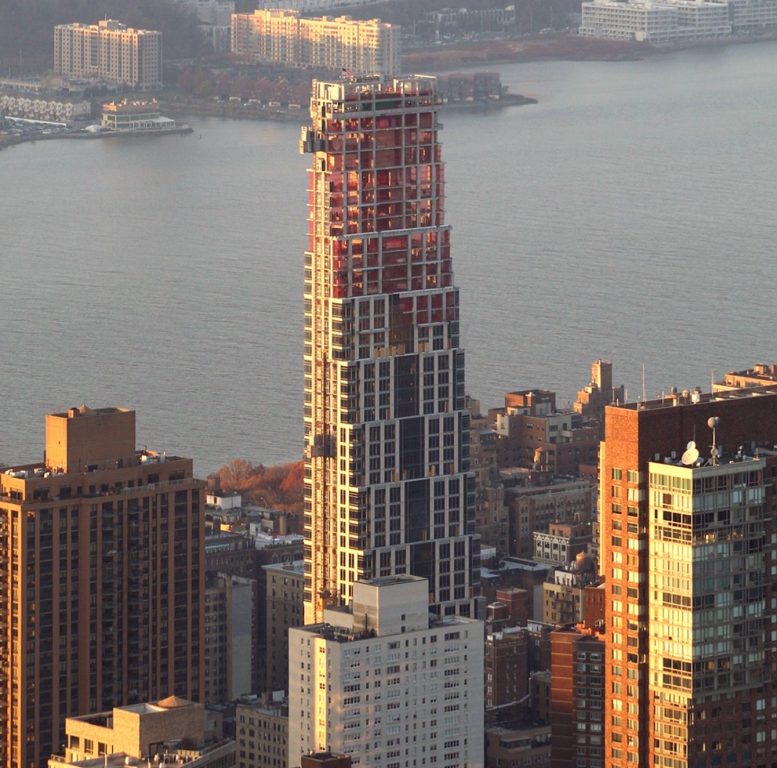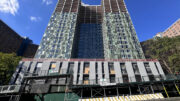Developers of the Upper West Side’s tallest building, 200 Amsterdam Avenue, were dealt an unprecedented blow last week when a State Supreme Court Judge ruled that 20 or more floors may have to be lopped from the residential skyscraper. Developers SJP Properties and Mitsui Fudosan America are in the process of appealing the decision, which is the latest in a string of community-led attacks on development throughout the city.
While other recent injunctions have prevented projects from breaking ground, this edict comes after the 52-story building had already topped out and work was heading for completion.
“This ruling sets a dangerous precedent for the future of development in this city,” said Steven Pozycki, founder, chairman, and CEO of SJP Properties. “It will send a message to investors that the administration of land use controls in New York City can be upended, and substantial investments can be wiped out, by even a single individual who is unhappy with the building permitted by those controls.”
Opponents of the project, led by civic organizations including the Municipal Arts Society (MAS), contend that the developers skirted regulations by using a “gerrymandered” 39-sided plot in order to maximize the height of the 668-foot-tall tower.
“We’re concerned that this technique of assembling zoning lots in this way would be used in other cases across the city and set a very dangerous precedent for the creation of unpredictable developments,” said Elizabeth Goldstein, president of the MAS. “The development is out of scale for what a reasonable citizen would expect to happen in that community based on the zoning resolution and the application of straightforward principles.”
Legal representatives for the development team disagree on all grounds. “The reality is that there’s nothing nefarious about it,” said Paul Selver, partner at Kramer Levin, which is representing the developers. “If the whole block was one zoning lot, you could still build the exact same building. The gerrymandering didn’t create this building; the fact that you have a superblock created the ability to build this building. And that superblock goes back to Robert Moses times.”

200 Amsterdam Avenue in the fall of 2019. The curtain wall now extends almost to the crown. Photo by Michael Young
According to Selver, the origins of the oddly shaped lot go back to 1987, when then-owners of the neighboring Lincoln Towers complex pieced together plots of vacant land for the purpose of development, including portions of existing tax lots. In 2007, this zoning lot was merged with other tax lots to form a larger zoning lot that included the 200 Amsterdam parcel.
“That’s the issue: whether or not you can have a zoning lot that’s composed of portions of tax lots, or whether you can only have a zoning lot that’s composed of core tax lots,” Selver said. And, according to Selver, history sides with the former. “It’s not that common, but it’s established,” he said, pointing to Park Avenue’s MetLife Building (formerly Pan Am) as the most prominent example of a project constructed in this way.
In total, 20 other buildings around the city have been built using partial tax lots. In addition to containing almost 2,300 apartments, the buildings are burdened by hundreds of millions of dollars in mortgage loans. “The judge has put the city in a little bit of a pickle here,” Selver said. “[His ruling] technically means that those certificates of occupancy are illegal, because the zoning lots on which they’re based are not legal.”
In fact, three of these buildings—200 West End Avenue, 180 Amsterdam Avenue, and 160 Amsterdam Avenue—were built right next to 200 Amsterdam on the gerrymandered lot, with work concluding as recently as 2013. “You didn’t hear anybody say a peep,” Selver said. “There was not a sound raised about gerrymandered zoning lots when people were building those buildings.”

Under the ruling, 200 Amsterdam Avenue’s dramatic crown would have to be removed. Rendering by Elkus Manfredi Architects
Indeed, Selver said that the Department of Buildings’ (DOB) decision to grant 200 Amsterdam’s developers a permit was consistent with the way it has interpreted zoning laws for 40 years. Further, the DOB’s determination was upheld by the Board of Standards and Appeals following a two-year period of document review and testimony. It was against this backdrop that SJP proceeded with its $325 million investment in the project; the team wasn’t “building at their own peril,” as Richard D. Emery, a legal counsel for an opposing community group, opined to the New York Times.
“[Over the last] 40 years, you have 34 DOB decisions that are made consistent with allowing partial tax lots to be part of zoning lots, and no decisions—literally no decisions—being made that say you can’t have a partial tax lot as part of a zoning lot,” Selver said. “If there was a reason to be concerned here, you would have expected that somebody would have said ‘Wait a minute, no, you can’t do this.’ But the Buildings Department, each time it conducted a thorough plan review, said on 34 separate occasions that you can do this.”
The ruling on 200 Amsterdam comes on the heels of two other legal decisions to block major developments in Manhattan. In August of 2019, another State Supreme Court judge overruled the approval of the Two Bridges megaproject on the Lower East Side, which includes Extell’s completed One Manhattan Square. Three more condominium towers, including one supertall, were set to follow, but now the developers must go through a protracted citizens’ review process.
Then, in December of last year, a Manhattan Supreme Court Judge struck down a plan to rezone a 59-block stretch of Inwood that had been approved by the City Council in 2018. Opponents of these developments on opposite ends of the island cited fears of gentrification that would threaten the affordability of the neighborhoods for longstanding residents, despite the fact that the Inwood plan called for the creation of 1,600 affordable homes.
“What we’re concerned about is that communities, and the city for that matter, are able to understand what might happen under the zoning resolution in any particular neighborhood,” MAS’s Goldstein said.
Developers are fearful that rulings like these and the one facing 200 Amsterdam could lead to long-term economic consequences that extend far beyond the community level. “This ruling has created uncertainty and alarm for all New York City developers, and we may well start to see investors and developers shifting their focus away from New York and choosing to focus on other cities—with the obviously detrimental impact on local jobs, housing costs, public services, and taxes,” SJP’s Pozycki said.
However, Selver has faith in the appeal process, and believes that 200 Amsterdam will eventually get back on track. “Notwithstanding this ruling, we have a lot of confidence in our client’s position,” he said. “It is grossly unfair and unreasonable to apply this decision retroactively and it’s going to create some measure of havoc in the city, quite frankly, if it sticks.”
Subscribe to YIMBY’s daily e-mail
Follow YIMBYgram for real-time photo updates
Like YIMBY on Facebook
Follow YIMBY’s Twitter for the latest in YIMBYnews






Everyone take a deep breath.
It’s too late as everyone signed off on the project. This mess can be avoided in the future by clarifying what is legally allowed with “gerrymandered” lots.
The damage is done! Let it be a lesson to the other “investors” plotting to destroy the beauty of New York hoping some more billionaires would invest in some of those architectural monstrosities…This situation will be a lawyers goldmine!
Since it is done the extra 20 floors should be rented to low income families using the same lobby and elevators as the other residents!
i go to high school a couple blocks away from this building and i find this decision dumb. there are many high rises in this neighborhood below 72nd st. This building does not intrude this neighborhood at all 72nd street is busy intersection with fast food chains and tall buildings surrounding it. this building uses classical New York setbacks in its design to let light into the street and is modest in height for a skyscraper during the age of residential giants. obviously this ruling was more of a message since its definitely going to be overturned but still don’t think this site deserved this message :/
I understand the communities position, but once this building was approved by the DOB and now its up the time for protest is over. what happens to all the trades and people that have their own money tied up in this project besides the owners, banks and investors, something like this can put people in the community in the poor house. the time to debate this was in the planning stages, A serious disconnect exists, If something needs to change, it needs to change before millions of dollars being lost is on the line.
So, activists knee-jerk oppose tall buildings in Manhattan – home of the world’s largest concentration of tall buildings? I can understand if 200 Amsterdam was proposed for Manhasset. Or Massapequa. But Manhattan? I don’t understand the opposition. NYC is on a construction roll right now. Which means investors see the city as a win, which encourages for investments. A very good thing. Of course not all projects are good, or should be built no matter what (like in China: a building is proposed, and starts construction immediately. No community input allowed.) But 200 Amstetdam looks nicely suited where it is. If activists don’t like tall buildings, then move to a city that doesnt have them.
I completely agree with you…why would anyone in NYC…Manhattan no less expect Not to be surrounded by skyscrapers. I say let the Great Metropolis grow…let those skyscrapers rise to even greater heights. And tell the whiners to move across the river if they don’t like it.
Totally agree – NYC is not, nor should it be a museum. Think of all the icons we would not have by freezing the built environment in time. Also, I don’t understand how people think they have the “right” to live in a location in perpetuity. I can’t afford the neighborhood that I grew up in. I’m not entitled to geography, just the ability to work harder to afford the best I can get. Without growth there will be an even greater housing crisis. Shutting down development will further stoke the fires of unaffordability. Clawing back permits long after the fact is ridiculous. It is the domain of the entitled, bratty, selfish, and worst among us. While NYC shouldn’t become purely super luxury, curtailing development is a fools errand. Maybe “these people” should put their energy into campaigning for more middle income development rather than cutting the developers off at the knees.
You guys also like the blocking of light by the supertalls eh? This building is actually nice… How many of you LIVE in NYC???
TY, Neal
Me. Its Manhattan. If I wanted to live in constant sunlight I’d live where every structure is single or two-story.
Those supertalls hardly block a sliver of light…pretend you are in the shadow of the Rocky Mountains and it won’t bother you so much 🙂
Yay! Communities finally win one! Let’s chop down some more!!!
Truly unbelievable that a few Neanderthal knuckle draggers oppose tall buildings in Manhattan. Perhaps developers could offer these cave dwellers relocation money to shut them up. Just saying.
lol,,,they can carve out a cave in the Palisades Escarpment
“You didn’t hear anybody say a peep,” Selver said. “There was not a sound raised about gerrymandered zoning lots when people were building those buildings.”
Wow great point I wonder what it was about this 668-foot-tall tower that made people react differently.
Was this issue not brought up back in 2018 when it was still a hole in the ground?
Until any possible litigation and appeals are exhausted, developers proceed at their own risk.
hey, ny… since humpty dumpty nadler failed in impeachment, he’s turning his shell towards his home town wall… enjoy, enjoy…
if you need help with a pencil-neck eraser to get rid of 20 floors, call aunt nancy, she knows how to ‘rip’ things up!
seriously…must you invoke all that. JC ON A CRUTCH
Insipid and embarrassing. I can’t believe I’m the same species as you.
This reminds me of demonstrations and screaming, complaints and anger of The upper West side activists when the development of the buildings now on Riverside Boulevard was going on and the moment the first building was approaching completion all those tumlers came running to buy or rent apartments in those buildings. Im willing to bet that 200 will proceed and the same thing will happen.NBS
A 39 sided lot made of partial tax lots was never intended by a clear reading of the zoning resolution. The DOB admitted fault in issuing the permit. Why should generations of New Yorkers suffer the consequences? The shadows will envelop the neighborhood forever. The developer also continued building (above the zoning allowance) at their own risk.
Shadows!!! Oh the humanity… Hilarious.
Its Manhattan. Home of the world’s largest concentration of skyscrapers. Shadows are to be expected. If NYC had used the “shadows” reasoning 100 years ago, NO tall building would have been constructed. And today it would be jammed with cottages.
Unbelievable. Now what, cut off the illuminated crown & leave the neighborhood with another squat box?
What a sad, sad, sad decision…. this would be a beautiful stately piece of architecture in sort of dull part of Manhattan.
I am pro development but this clearly is a case of a greedy developer trying to shortcut their way to profits. There were many warning signs and opposition in the planning stages that should have been resolved FULLY up front. 99.999999% of development in the city is unaffected by this ‘precendent’ which hopefully makes the small number of greedy developers think twice in the future trying to shortcut and ‘beat the system” which then gives the rest of us developers a bad reputation. SJP Properties should be ashamed of themselves.
Oh, the poor developers. Their greed knows no bounds. Build large glass supertall buildings which dwarf appropriate buildings with some connection to the ground, build them by tricking the community, like 50 W. 66th St (first it was a 25 story building, now its 90 or more floors, huh!) and pay off DOB personnel (one can only imagine). The developers are not the victims, the residents of the city are the victims to the developers’ lies, pay offs, and now their whining. Boo hoo.
So should there be any limit at all to development? Should every block have 100 stories on it? Is there no environmental or health impact from packing more and more into a very small space? Does anyone care? Or is it all about profit for a very few people? Does it not bother anyone that huge buildings keep going up 1/2 are empty? I hope nobody dies in an ambulance trying to get through the extra traffic generated by huge buildings.
Its Manhattan. Skyscrapers. Density. Crowds. Understandably It’s not for everyone. For those they can live in the suburbs. Or a part of the city with only one or two stories.
turn it into a homeless shelter
hilariously enough that’s probably a very realistic outcome.. this is going to be an ugly and painful appeal process and 8 months from now a ruling that isn’t clearly a win or loss for the community or the developer will be the path the city/state ends up hobbling towards.. too much at stake to make them take it down, too much at stake to overturn and sweep it under the carpet
This is all about the school zone. A bunch of existing buildings were gerrymandered out of the PS199 school zone to make way for the wealthy residents of 200 Amsterdam.
This article doesn’t actually summarize the entire issue- it was not just the zoning lot that was the issue, it was also manipulation of the Open Space Ratio, one of the foundations of tower-in-the-park zoning. There should absolutely a building of this size on this lot, but it should have gone through ULURP. And let it go with the shadows already.
I think the complaint about the shadow this building casts is a red herring. I know this neighborhood well, and how much shadow there will be for this neighborhood won’t change one bit even if 20 floors are taken off the top.
Can yimby please post a link to the judges decision so that people can comment on its validity or absurdity?
Zoning law is complex and no doubt a SC judge (With Mayb no prior exposure to zoning precedent) getting up to speed gives me doubts- and are judges at the lower courts appointed by political officials?
Begs the question of whether a career path judge wants a politically unpopular decision on their resume?
Strategy rule in favor of politics, let the higher courts take the blame if reversed???
given the situation, everyone should just agree to make this affordable housing
Stop mischaracterizing the rezoning Inwood. Plenty of pro-development people hated the garbage plan that the city forced through and wasted three years of propaganda on. (Ydanis Rodriguez gets a lot of the blame too for his meddling.) And no, it would not have generated 1,600 affordable units — those numbers were always made up, but lazy publications just repeated whatever EDC put in the press release.
There are two cogent comments here. One is the fact that enormous amounts of money were already spent before the politically correct spoiler crowd got involved, and the second is the gerrymandering of local neighbors to less desirable schools to make room for the new wealthier residents. The rest seems like more mist and fog.